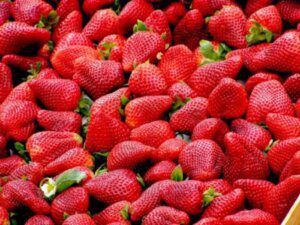When we think of strawberries, our taste buds immediately anticipate how sweet and delicious they will be. But what about our furry counterparts? Can dogs also share in this exciting harvest? Can dogs eat strawberries? In this comprehensive guide, we’ll explore the world of strawberries and how they suit our canine friends.
We will examine safety aspects, assess nutritional benefits, provide preparation advice, highlight potential risks, and provide nutritional guidance to ensure an appropriate course of treatment for strawberries for our dogs.

Can dogs eat strawberries? How do I prepare them? How do you prepare strawberries for dogs? What are the potential dangers? Read ahead to find out more.
Nutritional value of strawberries

Understanding a food’s nutritional content is crucial before giving it to our dogs. Strawberries, among other foods, can induce allergic reactions in dogs.
Stop eating strawberries and consult your veterinarian if you develop any allergy symptoms like pain, redness, constipation, or digestive difficulties after eating them.
These antioxidants can help prevent oxidative stress and improve dogs’ overall well-being.
Protein in strawberries
While strawberries are not a major source of protein, they do contribute significantly to a dog’s diet. Protein is essential for muscle repair and growth, and while dogs primarily need protein from animals, the small amount of protein in strawberries can be considered an alternative.
Carbohydrates in strawberries
Strawberries are extremely low in carbohydrates, making them perfect for dogs that need a controlled amount of carbohydrates.
Dogs are generally more tolerant of the natural sugars in strawberries, but it is important to remember that proper consumption is key when adding carbohydrates to their diet.
Fats in strawberries
Strawberries are actually low-fat fruit and are useful for dogs that need a low-fat diet due to certain health conditions.
However, it’s important to note that dog food still needs essential fatty acids, which are best obtained from fats of animal origin rather than fruits or vegetables.
Preparation
Before feeding strawberries to your furry friend, it’s important to prepare them well. Start by choosing fresh, ripe strawberries, making sure they have no signs of mould or damage.
Wash strawberries thoroughly to remove dirt or pesticides. It is advisable to remove the roots and leaves as they can pose a choking hazard or upset stomach. Cut strawberries into bite-sized pieces to make them easier for your dog to chew and swallow.
Best practices for making strawberries for dogs
Rinse strawberries under cold running water to remove any possible residue.
Pat the strawberries gently with a clean towel to dry or air dry.
Remove the stems and leaves, making sure only the fleshy part of the fruit remains.
Cut strawberries into appropriate sizes, considering the breed and size of your dog.
It is always a good idea to add strawberries to your dog’s diet to check tolerance and possible allergies.
Safety Precautions
Although strawberries are generally safe for dogs to eat, it is important to be aware of any potential hazards. Here are some safety advice to remember:
Potential dangers of strawberries for dogs
Strawberries, among other foods, can induce allergic reactions in dogs. Stop eating strawberries and consult your veterinarian if you develop any allergy symptoms like pain, redness, constipation, or digestive difficulties after eating them.
Strawberries should be chopped into small pieces and their stems removed to reduce the risk of choking, as was previously noted. Always supervise your dog while he eats strawberries to make sure he is chewing and swallowing safely.
Strawberries are one of the fruits that can retain pesticide residue even after washing. Choose organic strawberries whenever possible or thoroughly wash regularly grown strawberries to minimize potential pesticide exposure.
Feeding tips
While strawberries can be a healthy addition to your dog’s diet, seasoning is key. Here are some common eating guidelines to consider.
How much can dogs eat strawberries?
The right amount of strawberries for your dog depends on size, weight and individual dietary needs. As a general rule of thumb, aim for strawberries as a treat, no more than 10% of your dog’s daily caloric intake.
For concrete recommendations, talk to your veterinarian, who can assess your dog’s specific needs.
How often can dogs eat strawberries?
Strawberries can be served as an occasional treat instead of a regular part of your dog’s diet. You can incorporate strawberries into their activities, but make sure they get a well-balanced and complete diet that is basically nutritionally adequate dog food.
Can Dogs Eat Strawberry Jam?
Knowing which meals are healthy for our animal friends is essential when it comes to feeding them. Can dogs eat strawberry jam, a common spread that many people like? Strawberry jam may be dangerous for our canine friends, so it’s important to exercise caution.
Although strawberries by themselves are often good for dogs, jam’s extra sugar and other chemicals can be harmful to their health. Before choosing to add strawberry jam to your dog’s food, it is important to consider the benefits and risks.
The sweet flavour of strawberry jam may be tempting to dogs, but it is recommended to avoid providing it to them due to the risks connected with the extra sugar and other chemicals.
Choose fresh strawberries as your dog’s occasional treat instead. Prioritize the health and well-being of your dog at all times by contacting a veterinarian before adding new items to their diet. Making wise decisions can help you keep your beloved friend secure and healthy.
Can dogs eat strawberry leaves?
As dog owners, we frequently question whether certain meals are safe for our canine pets. It’s necessary to be careful when handling strawberry leaves.
In small amounts, strawberries are often healthy for dogs, but the leaves can be dangerous.
While dogs could be drawn to the leaves, it’s vital to be aware of the risks and make wise choices on what we give our animals.
It is advisable to keep your dog away from strawberry leaves.
The leaves can be difficult to digest and may result in stomach discomfort or gastrointestinal problems in certain dogs, even though they are not particularly harmful.
If your dog unintentionally ingests strawberry leaves, keep an eye out for any symptoms of pain or odd behaviour, and seek medical advice if required.
As usual, it’s crucial to put your dog’s health and well-being first by giving them balanced and suitable food.
Can dogs eat strawberry ice cream?
It’s common for dog owners to want to give their pets their favourite treats. Strawberry ice cream may seem like a delicious alternative, but before offering it to your dog, it’s important to consider the advantages and disadvantages.
While strawberries by themselves are mostly healthy for dogs, some types of ice cream, notably those with strawberry flavours, might cause problems.
Giving strawberry ice cream to dogs is generally not advised. Strawberries are typically healthy and safe for dogs, but the ice cream portion can be troublesome.
Dogs who consume ice cream may experience digestive difficulties, weight gain, and even more severe health issues as a result of the high sugar and fat content of the treat.
likewise, because some dogs may be lactose-sensitive, dairy-based ice cream is especially inappropriate for dogs.
As an alternative, think about treating your dog to some fresh strawberries every now and again, but make sure the rest of their food is balanced and meets their nutritional needs.
For specific advice on your dog’s nutrition and any special dietary needs, always see your veterinarian.
Related: Can Dogs Eat Sesame Seeds? Exploring the Sesame Seed Saga for Dogs
Conclusion
In conclusion, strawberries can be a safe and healthy treat for dogs when administered appropriately and prepared accordingly. Their high nutritional value, including vitamins, minerals and antioxidants, can help improve your dog’s overall health.
Remember to wash the strawberries, remove the stems and cut them into appropriate sizes before serving them to your furry friend. Watch out for allergens or choking hazards, and always consult your veterinarian for personalized dietary recommendations.
By following these guidelines and considering your dog’s individual needs, you can safely treat your canine companion with the delightful flavour of strawberry juice. So go ahead, share this fruitful joy with your four-legged friend and cherish those sweet moments together!


